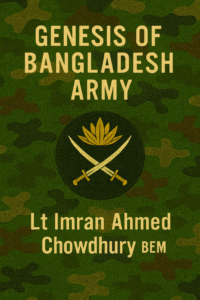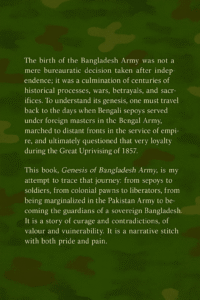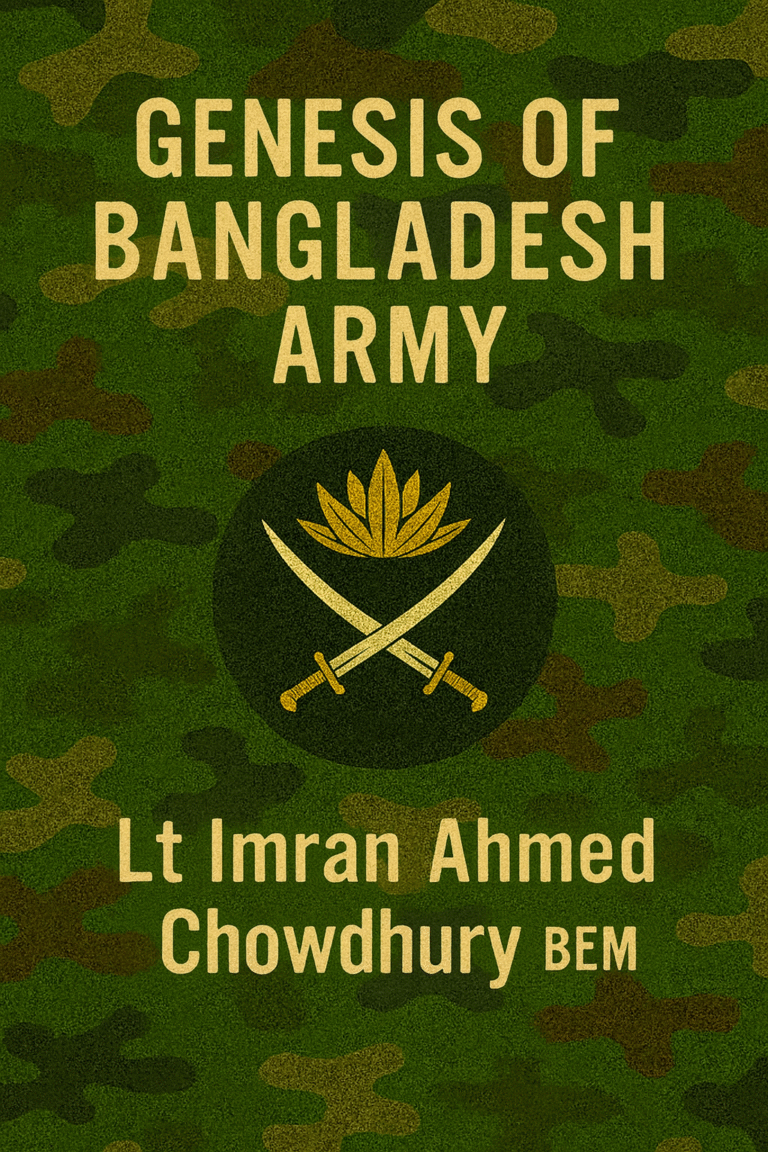)
Genesis of Bangladesh Army: A History of Power, Politics, and Soldiers
is a groundbreaking narrative that traces the tumultuous journey of the Bangladesh Army — from its colonial roots to its controversial role in the making and unmaking of the nation.
The book begins in the late eighteenth century, when Bengali soldiers served in the East India Company’s Bengal Army and fought in uprisings such as the Barrackpore Mutiny of 1824 and the Revolt of 1857. Yet, after 1857, Bengalis were branded a “non-martial race” and excluded from combat roles. This exclusion forced a political rather than military awakening in Bengal, laying the psychological foundations of a people’s desire for self-determination.
Through World War I and World War II, Bengali recruits challenged stereotypes, fought with distinction, and built a military identity that later crystallized in the East Bengal Regiment. But Partition in 1947 produced a Pakistan Army dominated by Punjabis and Pathans, leaving Bengalis marginalized despite being the majority population. The East Bengal Regiment, formed in 1948, was a symbolic concession, yet its officers faced systemic bias and exclusion.
The book then explores Ayub Khan’s martial law, Yahya Khan’s disastrous rule, the 1970 election crisis, and the genocide of March 1971. It highlights the central role of the East Pakistan Rifles (EPR), Mukti Bahini, and defected officers in the Liberation War, while critically examining the paradox: many officers trained in Pakistan fought for independence but remained psychologically conditioned by its anti-India ethos.
The post-independence years (1972–1975) were marked by division. The return of repatriated officers from Pakistani captivity created a fractured mix of freedom fighters, EPR veterans, and Pakistani-trained repatriates. Juniors leapfrogged into senior ranks, sparking jealousy and suspicions of disloyalty. Some repatriates, anonymous sources claim, even conspired in coup plots. This toxic rivalry culminated in 1975: Mujib’s assassination, the jail killings, Khaled Musharraf’s failed coup, the sepoy mutiny of Abu Taher, and the rise of Ziaur Rahman.
From there, the book examines Zia’s consolidation of power, his appeasement of repatriates, suppression of freedom-fighter officers, and the embedding of Pakistan’s martial law culture. Ershad’s 1982 coup deepened corruption and Islamisation, earning him the reputation of a “traitor of the century.”
The restoration of democracy in the 1990s is portrayed not as a victory of civilian rule but as “democracy in disguise,” with Khaleda Zia and Sheikh Hasina often acting as civilian proxies for military interests. Later chapters cover BNP-Jamaat’s rule, the 1/11 army-backed caretaker regime under General Moeen, and Hasina’s long rule from 2009, during which she co-opted the army through patronage, UN peacekeeping, and contracts.
Yet the army’s internal divisions remain visible: cadet-college elitism, secular vs Islamist leanings, patronage coteries, and suspicion of radical infiltration. The book shows how the army evolved from coup-maker to cautious professional, with younger officers uninterested in seizing power but content in stability and privileges.


This is not merely a military history. It is a story of paradox: of guardians who became rulers, of patriots tarnished by disloyalty, of freedom fighters sidelined, and of Pakistan’s martial law ghost haunting Bangladesh in new uniforms. It is a damning indictment of fractures that undermined national unity, and a tribute to the bravery of those who fought and fell in 1971.
Rich in historical detail, critical in tone, and unapologetically honest, Genesis of Bangladesh Army is essential reading for anyone seeking to understand how the destiny of Bangladesh was shaped — and continues to be shaped — by the men in uniform.


You can buy this book from Amazon:
https://www.amazon.co.uk/s?k=imran+chowdhury+bem+books&crid=2WR2I9XN23SJR&sprefix=%2Caps%2C94&ref=nb_sb_ss_recent_4_0_recent



